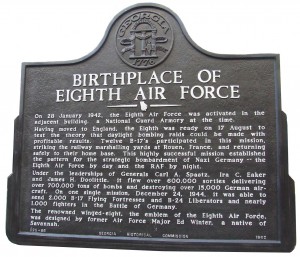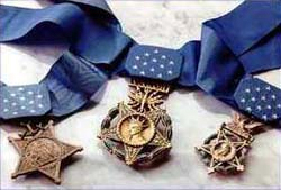The Mighty Eighth Air Force
 The
Eighth Bomber Command (Re-designated 8th AF in February 1944) was
activated as part of the United States Army Air Forces January 28,
1942, at Hunter Field in Savannah, Georgia. Brigadier General Ira
C. Eaker took the headquarters to England the next month to prepare
for its mission of conducting aerial bombardment missions against
Nazi-occupied Europe. During World War II, under the leadership
of such Generals as Eaker and Jimmy Doolittle, the 8th AF became
the greatest air armada in history. By mid-1944, the 8th AF had
reached a total strength of more than 200,000 people (it is estimated
that more than 350,000 Americans served in 8th AF during the war
in Europe). At its peak, the 8th AF could dispatch more than 2,000
four-engine bombers and 1,000 fighters on a single mission. For
these reasons, the 8th AF became known as the "Mighty Eighth".
The
Eighth Bomber Command (Re-designated 8th AF in February 1944) was
activated as part of the United States Army Air Forces January 28,
1942, at Hunter Field in Savannah, Georgia. Brigadier General Ira
C. Eaker took the headquarters to England the next month to prepare
for its mission of conducting aerial bombardment missions against
Nazi-occupied Europe. During World War II, under the leadership
of such Generals as Eaker and Jimmy Doolittle, the 8th AF became
the greatest air armada in history. By mid-1944, the 8th AF had
reached a total strength of more than 200,000 people (it is estimated
that more than 350,000 Americans served in 8th AF during the war
in Europe). At its peak, the 8th AF could dispatch more than 2,000
four-engine bombers and 1,000 fighters on a single mission. For
these reasons, the 8th AF became known as the "Mighty Eighth".
 The
Mighty Eighth compiled an impressive record in the war. This achievement,
however, carried a high price. The 8th AF suffered one-half of the
U.S. Army Air Forces’ casualties in World War II (47,000-plus casualties
with more than 26,000 deaths). The Eighth’s personnel also earned
17 Medals of Honor, 220 Distinguished Service Crosses, 850 Silver
Stars, 7,000 Purple Hearts 46,000 Air Medals. Many more uncounted
awards were presented to the 8th AF veterans after the war. There
were 261 fighter aces and 305 gunner aces in the Eighth in World
War II; 31 of those fighter aces exceeded 15 or more aircraft kills.
The
Mighty Eighth compiled an impressive record in the war. This achievement,
however, carried a high price. The 8th AF suffered one-half of the
U.S. Army Air Forces’ casualties in World War II (47,000-plus casualties
with more than 26,000 deaths). The Eighth’s personnel also earned
17 Medals of Honor, 220 Distinguished Service Crosses, 850 Silver
Stars, 7,000 Purple Hearts 46,000 Air Medals. Many more uncounted
awards were presented to the 8th AF veterans after the war. There
were 261 fighter aces and 305 gunner aces in the Eighth in World
War II; 31 of those fighter aces exceeded 15 or more aircraft kills.
 After the war in Europe, in July 1945, the 8th AF headquarters moved
to Okinawa, where it trained new bomber groups for combat against
Japan. The Japanese, however, surrendered before the 8th AF saw
action in the Pacific Theater. In June 1946, the headquarters moved
to McDill Field, Florida, to become part of the newly established
Strategic Air Command. Four years later; November 1950, the 8th
AF headquarters transferred to Fort Worth Army Field (later Carswell
Air Force Base) in Texas.
After the war in Europe, in July 1945, the 8th AF headquarters moved
to Okinawa, where it trained new bomber groups for combat against
Japan. The Japanese, however, surrendered before the 8th AF saw
action in the Pacific Theater. In June 1946, the headquarters moved
to McDill Field, Florida, to become part of the newly established
Strategic Air Command. Four years later; November 1950, the 8th
AF headquarters transferred to Fort Worth Army Field (later Carswell
Air Force Base) in Texas.
During the Korean War, several 8th AF units deployed to Japan to fly combat missions. Following, the Eighth spent its next few years building its strategic capabilities. On June 13, 1955, the 8th AF moved to Westover, Massachusetts, where it guided the transition of its units into the jet age with the B-47 and the KC-97 aircraft. The Air Force phased out those aircraft in the early 1960s for newer B-58 and B-52 bombers, and KC-135 tankers. Additionally, the Eighth acquired Atlas and Titan intercontinental ballistic missiles.
In 1965, the 8th AF started performing combat operations in support of the Southeast Asian Conflict. At first, stateside-based 8th AF wings deployed periodically to operating bases in Guam, Okinawa, and Thailand, but then in April 1970, the headquarters moved to Andersen AFB, Guam, to take over the direction of all strategic operations. The intensive bombing of Hanoi and Haiphong during 11 days in December 1972, known as LINEBACKER 2 or the "Christmas Day Bombing Campaign," was but one highlight of that period. Those missions influenced the North Vietnamese government to return to the negotiating table. After the hostilities ended in Southeast Asia, the 8th AF moved to Barksdale on January 1, 1975.
Eighth AF units played a key role in Desert Storm by spreading the Gulf War air campaign. Launched from Barksdale AFB, Louisiana, B-52s conducted effective conventional air-launched cruise missile strikes on numerous Iraqi targets to open the war. Numbered air force bomber units in the theater and at nearby locations also attacked Iraq’s Republican Guard and other important strategic targets, while air refueling units provided most of the support to Coalition aircraft. Other assets provided tactical reconnaissance.
After Desert Storm, the Mighty Eighth reorganized to become a general-purpose numbered air force with a war fighting mission to support the U.S. Strategic Command. The Eighth currently demonstrates that role in yearly large-scale exercises. In 1996, the Eighth also directed the highly successful Desert Strike mission against Iraq.
Story courtesy Mighty Eighth Air Force Museum
B17 Cutaway View
Interactive aircraft diagram with photographic details.